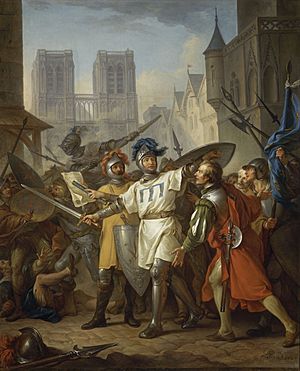Siege of Paris (1435–1436) facts for kids
Quick facts for kids Siege of Paris |
|||||||
|---|---|---|---|---|---|---|---|
| Part of the Hundred Years' War | |||||||
 |
|||||||
|
|||||||
| Belligerents | |||||||
| Commanders and leaders | |||||||
| Ambroise de Loré Arthur de Richemont Jean de Dunois |
|||||||
| Strength | |||||||
| 5,000 3,000 reinforcements |
5,000 soldiers of Arthur de Richemont Burgundian reinforcements |
||||||
The Siege of Paris in 1435-1436 was an important event during the Hundred Years' War. This long war was fought between England and France. At this time, the French army, led by Charles VII of France, was gaining strength. They wanted to take back their capital city, Paris, which had been controlled by the English since 1420.
Contents
Why Paris Was Attacked
The French army had been doing much better since Joan of Arc helped them win the siege of Orléans in 1429. After that victory, Joan tried to capture Paris herself in September 1429. However, King Charles VII stopped the attack after only four hours because it wasn't going well.
In 1435, King Charles decided to try again to take Paris. His forces won a battle at Gerberoy on May 9, 1435. This made the English defenses weaker. On June 1, French troops, called Armagnacs, quickly captured Saint-Denis, a town near Paris. This meant Paris was now surrounded, making it hard for food and supplies to get into the city.
However, taking Paris was tricky because two French groups, the Armagnacs and the Burgundians, were still fighting each other. The Burgundians were even helping the English at this time.
Peace Talks and New Friends
While the French, English, and Burgundians were talking about peace at the Congress of Arras, fighting continued around Saint-Denis. The English left the peace talks, but King Charles VII and Philip the Good, the Duke of Burgundy, signed a peace treaty on September 21. This meant the Burgundians were now friends with France again! Even though some Burgundian forces kept fighting at Saint-Denis for a short time, they soon joined the French side for the rest of the siege.
Who Was Fighting?
Here's a look at the main groups involved in the siege:
Supporting England
- About 3,000 English soldiers, mostly inside Paris.
- The University of Paris also supported the English.
- Around 2,000 "routiers" (soldiers who often worked for pay).
- About 3,000 English reinforcements were in other parts of the region.
Supporting France
- The French royal army, spread out in the area.
- About 5,000 soldiers led by Arthur de Richemont.
- Burgundian soldiers who joined the French side.
How Paris Was Taken
With the help of the Burgundian troops, the French army defeated the English and their helpers at Saint-Denis on April 6, 1436. This forced the English to go back inside the walls of Paris.
Now, the French army completely surrounded Paris. No food could get in. This caused the price of grain to go up four times in just two months, making it very hard for the people living in Paris.
On April 13, Arthur de Richemont, a French commander, arrived at the city walls. King Charles VII had promised to forgive anyone in Paris who had supported the English if they helped the French. This led to secret talks with some important citizens of Paris.
A Clever Plan
Six citizens, including Michel de Lallier and Jean de La Fontaine, agreed to help the French army get inside. They used a simple but smart trick:
- They started a small riot at the Porte Saint-Denis (Saint-Denis Gate) on the north side of the city.
- This made the English soldiers rush to that gate to stop the trouble. Paris had narrow streets, so it took a long time for soldiers to move from one gate to another.
- While the English were busy, the French royal forces quickly attacked the Porte Saint-Jacques (Saint-Jacques Gate) on the east side of the city. This gate was now not well-guarded.
Once the French captured the Saint-Jacques Gate, they easily reached important places like Les Halles (a market area) and Notre-Dame Cathedral.
The English soldiers found themselves fighting in the streets. People living in Paris even threw things at them from their windows! The English had to retreat to the Bastille Saint-Antoine, a strong fortress. On April 17, the English soldiers were allowed to leave Paris safely and went to Rouen.
What Happened Next?
King Charles VII finally entered Paris on November 12, 1437. He was surprised by how much of the city had been damaged. Paris had suffered a lot from years of civil war and being occupied by the English. King Charles allowed all Parisians who had run away to come back, as long as they promised to be loyal to him.

